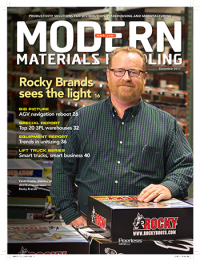The Big Picture: Navigation Gets a Reboot for Automatic Vehicles
Established guidance systems can now have been joined by new game-changing technologies. Instead of simply moving from Point A to Point B, AGVs and other automatic vehicles now can determine their own route and easily adapt to changes on the facility floor. That opens up a new world that might fit your future.
There’s a battle underway to win hearts and minds in the world of automatic guided vehicles (AGVs). In a word, it’s all about navigation.
Not long ago, every AGV system was guided by wires buried in the floor, laser targets on the walls, tape on the floor or in-floor magnets. But those established navigation systems have now been joined by on-board sensors including stereo cameras and LiDAR, two-dimensional lasers, three-dimensional lasers and a system called SLAM.
The impact of these new navigation systems has already been considerable, and that story is still young. Quite simply, AGVs that have always traveled a set path following a physical trail can now travel any path of their choosing without any physical trail at all. For the latest navigation systems, it’s all in the software, on-board sensors and lasers—talk about liberating.
“About 95% of what matters with AGVs is below the surface,” says Garry Koff, president of Savant Automation. In other words, while most people focus on the vehicle itself, that’s only a small part of what makes AGVs valuable automation partners in distribution centers and on manufacturing floors. Today, the most important aspect of that 95% is how a vehicle gets from its starting point to its destination.
“Navigation is the core of automated vehicles today,” says Simon Drexler, director of product development at Otto. “If the navigation stack is not capable, then everything else falls apart.”
That said, Savant does not offer any of the new navigation systems. Instead, it offers in-floor magnet guidance also known as inertial guidance. And Koff, along with many other AGV veterans, has some issues with the up-and-coming guidance systems. Common system challenges are throughput needs, repeatability, precision and fleet coordination as the technology itself evolves.
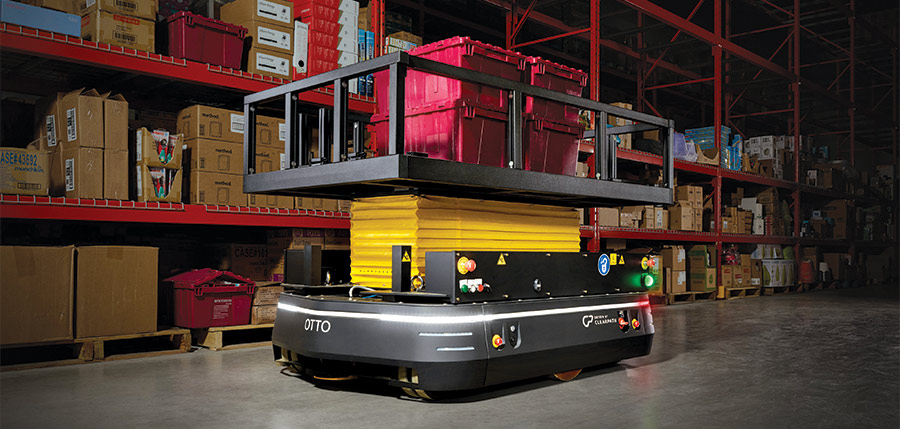
Yet, a company such as Whirlpool looked at all the options and chose AGVs with a stereo camera-based navigation system from Seegrid. Today, 54 robotic tuggers continuously deliver two dozen different washing machine parts to roughly 24 locations on sub-assembly and assembly lines in Clyde, Ohio.
“As a company, we’ve challenged our manufacturing plants to look for opportunities to implement smart automation,” says Jim Keppler, vice president of integrated supply chain and quality for the appliance manufacturer. “There is always labor savings associated with automation, but we are also looking for smart ways to improve safety, quality and speed.”
On the manufacturing side, General Electric, Deere and Caterpillar all use the Otto navigation system. Both RK Logistics Group and DHL on the distribution side use Fetch Robotics systems. Boeing, GM and Walgreens use systems from Seegrid. In fact, Seegrid’s vice president of product Jeff Christensen says his company’s camera technology has logged more than 750,000 miles of travel on facility floors.
In other words, the new navigation systems have impressed many.
As a result, the battle for the hearts of plant and DC managers and the minds of AGVs is being fought across distribution and manufacturing today—and, it’s a battle.
Quite simply, not every navigation system (old or new) is well suited to every application. That means decision makers must conduct their own evaluation of the applicability of the various guidance systems to their specific facility. A good place to start is with the big picture.
Looking at the big picture(s)
It’s worth noting here that AGVs are not the only automatic vehicles that use the new navigation systems. Others include automated lift trucks, autonomous mobile robots (AMRs) and guided carts. While AGVs and automated trucks have been around for a very long time, guided carts have appeared in the past 15 years and mobile robots in the past five.
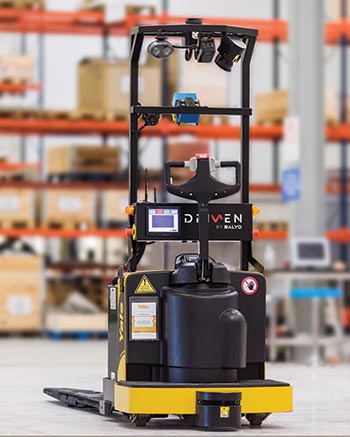 LiDAR (Light Detecting and Ranging) systems collect 50,000 data points every two seconds to guide the vehicle.
LiDAR (Light Detecting and Ranging) systems collect 50,000 data points every two seconds to guide the vehicle.
|
All have contributed to some degree to the evolution of autonomous vehicles and will continue to do so. In fact, the size of the market for systems with the new navigation systems will be the same size in 10 years as the market for traditional systems is today, according to Drexler of Otto.
The established guidance systems have been and continue to be very effective. But they have also had their own individual cycles of popularity during the past 35 years.
Wire, for instance, was originally the dominant form of guidance, but it’s rarely used today because it is so difficult to change the guide path buried in the floor. Wire is not alone in this limitation, and that is the nub of the problem for established navigation technologies.
It’s not news to anyone that the rate of change continues to accelerate. And as Whirlpool’s Keppler talks about safety, quality and speed, he must also take into account his company’s changing products and product mix. It’s no different in the distribution center, especially if it fulfills e-commerce orders.
“The goal in North America is to eliminate as many fixed materials handling structures as possible in the plant and warehouse,” says Tom Kaminski, Dematic’s vice president of mobile automation. By Kaminski’s estimates, a large number of facilities change at least one significant aspect of their layout once or twice a year.
While AGVs aren’t a fixed structure in and of themselves, they traditionally have followed fixed paths. That’s where the new navigation systems come into play.
Over at Yale Materials Handling, Lou Micheletto, manager of integrated solutions, notes the clear push across industry to get away from static, fixed paths for automatic vehicles. “The dynamics of changing operations at facilities of all types are demanding greater flexibility to the routes of automated vehicles including lift trucks.”
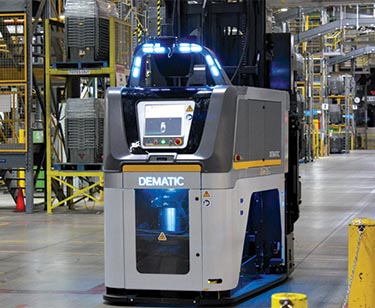 Despite greater route independence than possible historically, the new navigation
systems still pair with a central software system to coordinate traffic of individual
vehicles on the floor.
Despite greater route independence than possible historically, the new navigation
systems still pair with a central software system to coordinate traffic of individual
vehicles on the floor.
|
Melonee Wise, president of AMR supplier Fetch Robotics, adds some other big picture considerations behind the growth of the new navigation systems.
“Scalability and flexibility of these systems are becoming increasingly important,” Wise says. With the former, she is referring to the ability of systems to increase or decrease in size as load movement and demand fluctuate without degrading performance.
Flexibility is about more than just new facility layouts. It’s also about the need to adjust delivery paths on a real-time basis to help balance demand levels and work flow during any given day.
There’s also the big picture of time to install systems. Traditional systems typically require days or weeks to install the wires, magnets, tape and laser targets.
With the newer systems, no physical objects need to be installed anywhere in the facility. Instead, the vehicle is walked around the facility as it projects lasers or uses cameras to map the floor boundaries, fixed equipment, walls and other obstacles. Wise and others say it typically takes only a few hours to map a 250,000-square-foot facility.
“Not needing special guidance infrastructure is appealing because there is nothing extra to install, and over time, it makes for a system that is very flexible,” says Sarah Carlson, vice president of AutoGuide. “The newer forms of navigation match up well with the market need, which is all about constant change and keeping pace in a way that is simpler and less expensive.”
AutoGuide, by the way, does not supply any of the latest navigation systems. But its tape-based guidance system was installed recently by Ledvance for a fleet of AGV tuggers at its plant in Versailles, Ky. The company is a manufacturer of traditional and LED lighting products formerly known as Osram Sylvania.
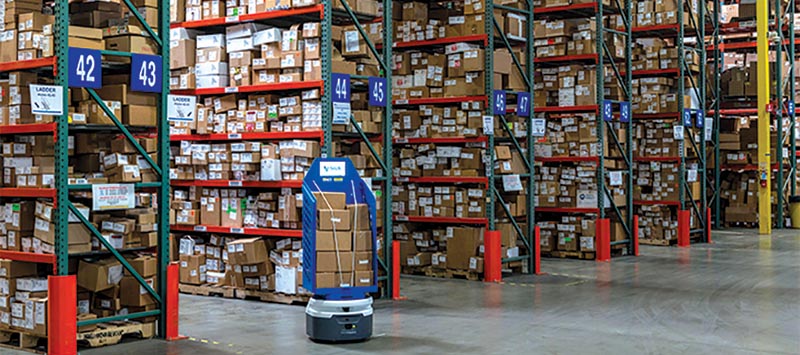
The new navigation systems can be used with vehicles as diverse as traditional AGV tuggers and autonomous mobile robots. Flexibility to accommodate changing workflow and destinations are easily accommodated by advanced navigation technologies.
The company also considered wire guidance and camera-based systems, says plant manager Mike McNulty. “We like the idea of spatial systems (cameras), but at the time didn’t think they had the install base that goes with a proven track record. And we didn’t want to put wire in the floor because our operations do change. Magnetic tape had the right balance between a proven track record and reliability,” adds McNulty.
He goes on to say, “as we move forward, the tugger isn’t going to change, but we recognize that the software, guidance systems and controls are evolving.”
The new navigation systems
Yes, there is an entirely new vocabulary that goes with the latest navigation systems. And to make things even more challenging, not all of the suppliers use the same terminology to describe a particular technology. Furthermore, there is no cookie-cutter approach that all use. Mixing and matching technologies is common.
“It’s more important that the navigation system works than what the exact technology is,” says Mark Longacre, applications engineering manager at JBT.
There are three broad categories of navigation technology. One uses planar lasers, a second uses cameras and lasers, and a third uses stereo cameras. The first two are licensed from non-vehicle suppliers to vehicle suppliers that need a navigation system. The third is a proprietary camera-only system.
It’s worth noting that certain suppliers have customized the core navigation technology with their own enhancements. Details vary supplier by supplier and are beyond the scope of this article. Following are brief explanations of the three broad categories.
The most commonly used technology today is known as natural environment or contour navigation. To learn how to navigate a facility, the vehicle moves along the floor (walking the vehicle), sending out two-dimensional lasers to detect objects anywhere from 10 feet to 30 feet distant.
These are planar lasers that are emitted at pre-set levels of a few inches above the floor to a few feet above. They only detect objects on those planes. When the signal returns to the vehicle, the data is processed by the Simultaneous Localization and Mapping (SLAM) system. Longacre compares SLAM to a football player who is looking for a hole in the opponent’s defense to run through.
Once the vehicle has gone back and forth across the entire facility, it creates a map. While it is an incomplete, two-dimensional map, it has sufficient detail to allow the vehicle to move freely. When combined with the vehicle’s safety system, safe navigation is easily achieved.
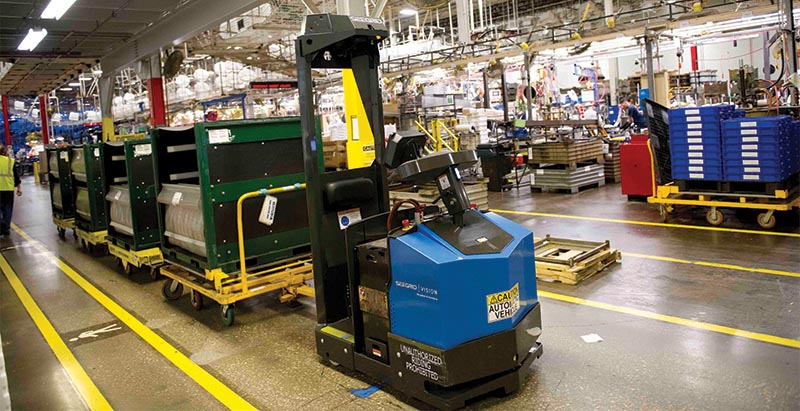
Whirlpool runs 54 robotic tuggers, each with a stereo camera-based navigation system, to deliver washing machine parts to 24 shop floor locations.
Although contour navigation is the most commonly used system, some look at it as a bridge technology as LiDAR (Light Detection and Ranging) systems develop and come down in cost.
LiDAR is a laser-based technology that produces a two-dimensional view of the facility, measuring the building structure by identifying features such as columns, walls and racking. More than 50,000 data points are collected every two seconds, says Yale’s Micheletto. The technology can be used to manage a single vehicle or an entire fleet, he adds.
Mapping with a LIDAR vehicle is accomplished as with contour mapping. Similarly, SLAM processes the data and develops a map to guide the vehicle on its route. “The vehicle has its own map of the facility and makes its own decisions on the route to follow to its destination,” says John Hayes, vice president sales and marketing for logistics at Vecna Robotics.
In fact, LiDAR is catching on as this story is being written. Daifuku is the latest to offer it on autonomous lift trucks in the fourth quarter, says Bruce Busher, vice president sales for the company’s smart handling business division.
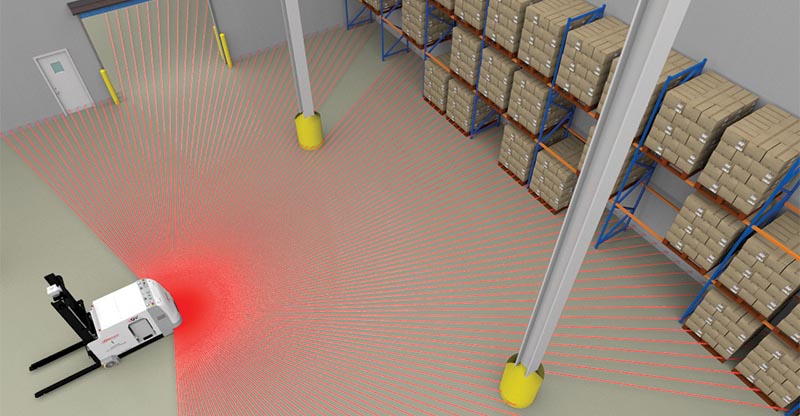
Two-dimensional lasers build a map of the facility and its features. The data is then used to guide the vehicle to targeted destinations without pre-setting routes.
The third of these systems is a stereo camera-based system. This system from Seegrid enables self-driving pallet trucks and tow tractors.
The technology uses five pairs of cameras on top of the vehicle chassis, creating 360-degree view of the vehicle’s surroundings. Every quarter second the system collects millions of data points from the five cameras. The data is processed on board, providing a detailed, data-dense map of what is where on the vehicle’s route to ensure reliable navigation in dynamic environments.
What to watch for
So the question remains: What guidance system is best for your application? This is a process that requires active research on your part.
Established technologies continue to be just that. And, they are primarily focused on moving along pre-determined paths.
For the three new technologies, the predetermined path scenario is not as important as how the vehicle gets there, says Wise of Fetch Robotics—and in that may lay some of your most important decisions.
There are at least three important considerations to take into account when conducting your evaluation, say Savant’s Koff, Daifuku’s Busher and Vecna’s Hayes.
All emphasize the importance of managing fleet traffic and system integration. In other words, it’s not enough that a vehicle can make its own decisions and plot its own route. In a fleet, there are multiple vehicles to manage at any point in time. The challenge is to coordinate all of the vehicle routes not just so they don’t run into each other, but so they also get to their destinations in a timely, repeatable manner.
There is also a concern for the safety perspective, especially safety of people on the floor. Some AMRs meet the same ANSI B56.5 safety standards that AGVs do. Some don’t. In fact, some AMR suppliers say that because they are not AGVs, their vehicles do not have to comply. System evaluations should evaluate the importance of this factor in your facility.
And, of course, there is the matter of highly repeatable delivery of loads to a destination with great accuracy. Some of the systems available today require human intervention to complete the delivery. Is that a viable scenario given your level of floor activity in a given day? Only you can make that decision.
By all measures, this is a new age for navigation of AGVs and other autonomous vehicles. It’s opening up new possibilities on busy distribution and manufacturing floors. It’s also a transitional time as suppliers work out the details of how systems operate at all levels. That said, now is your opportunity to think of what’s most advantageous to decide what fits your future.
Companies mentioned in this article:
- Autoguide
- Daifuku
- Dematic
- Fetch Robotics
- Otto
- JBT
- Savant Automation
- Seegrid
- Vecna Robotics
- Yale Materials Handling

Article Topics
Automation News & Resources
Walmart chooses Swisslog AS/RS and software for third milk processing facility Lucas Watson appointed CSO for Körber’s Parcel Logistics business in North America 60 Seconds with Bob Trebilcock, outgoing executive editor, Modern Materials Handling Kathleen Phelps to join FORTNA as chief financial officer Coles automates grocery distribution in Australia 2024 Intralogistics Robotics Survey: Robot demand surges Warehouse automation extends life of cheese DC by a decade More AutomationLatest in Materials Handling
Registration open for Pack Expo International 2024 Walmart chooses Swisslog AS/RS and software for third milk processing facility NetLogistik partners with Vuzix subsidiary Moviynt to offer mobility solutions for warehouses Materials Handling Robotics: The new world of heterogeneous robotic integration BSLBATT is looking for new distributors and resellers worldwide Lucas Watson appointed CSO for Körber’s Parcel Logistics business in North America Hyster recognizes Dealers of Distinction for 2023 More Materials HandlingSubscribe to Materials Handling Magazine

Find out what the world's most innovative companies are doing to improve productivity in their plants and distribution centers.
Start your FREE subscription today.
April 2024 Modern Materials Handling

Latest Resources



